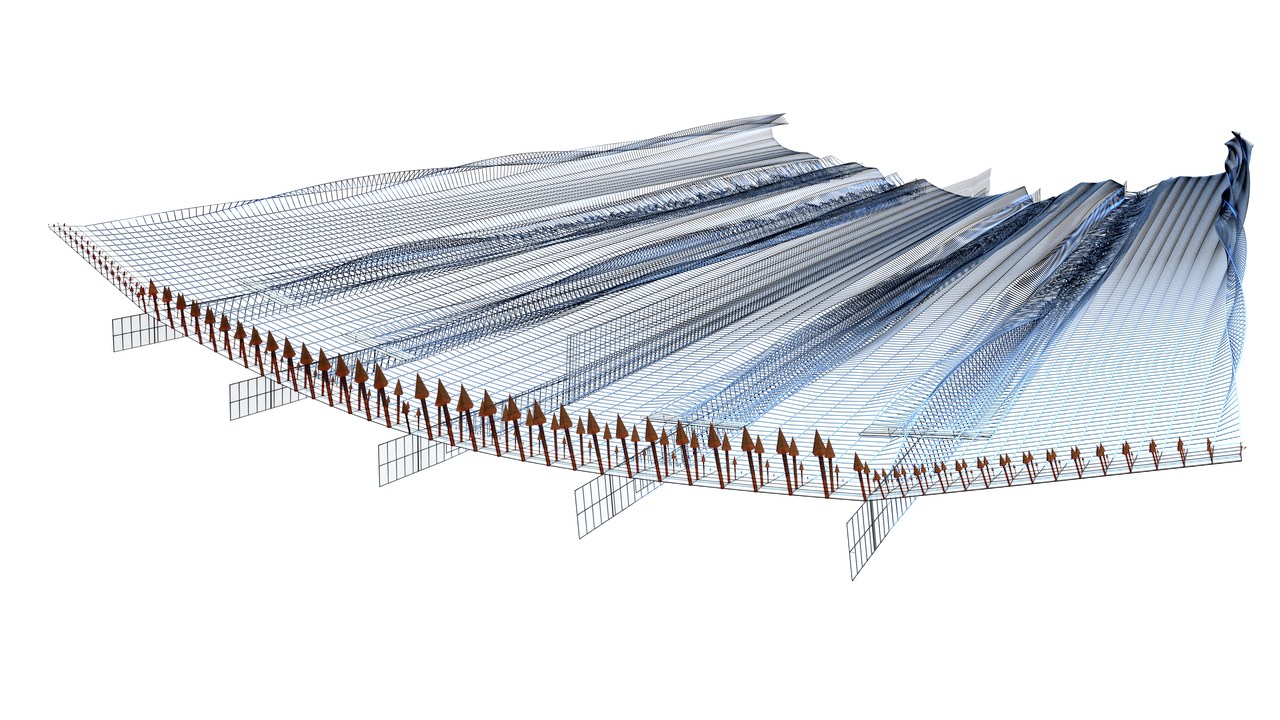SHARPy is a nonlinear aeroelastic analysis package originally developed at the Department of Aeronautics, Imperial College London. It can be used for the structural, aerodynamic and aeroelastic analysis of flexible wings, aircraft and wind turbines. It is shared here under a BSD 3-Clause permissive license.
For more information on the research team developing SHARPy or to get in touch, visit our homepage.
SHARPy is a modular aeroelastic solver that currently uses two specific models for the structural and aerodynamic response of the system.
For the structural model, SHARPy employs a geometrically-exact displacement-based composite beam formulation, augmented with Lagrange multipliers for additional kinematic constraints. This model has the advantage of providing the solution directly in the physical problem's degrees of freedom, making the coupling with the aerodynamic solver simple and not requiring any post-processing. The 1D beam formulation used limits the analyses that can be done by SHARPy to slender structures, such as high aspect ratio wings.
The aerodynamic model utilises the Unsteady Vortex Lattice Method (UVLM). The aerodynamic surfaces are modelled as a thin vortex ring lattice with the boundary conditions enforced at the collocation points in the middle of the vortex rings. The Kutta condition is also enforced at the trailing edge. The wake can be simulated by either additional vortex rings or by infinitely long horseshoe vortices, which are ideally suited for steady simulations only.
The aerodynamic model has recently been extended by a linear source panel method (SPM) to model nonlifting bodies for example fuselages. The SPM and UVLM can be coupled to model fuselage-wing configuration and a junction handling approach, based on phantom panels and circulation interpolation, has been added.
The input problems can be structural, aerodynamic or coupled, yielding an aeroelastic system.
The base solver SHARPy is a nonlinear aeroelastic analysis package that can be used on free-flying flexible aircraft, wings and wind turbines. In addition, it supports linearisation of these nonlinear systems about arbitrary conditions and includes various tools such as: model reduction or frequency analysis.
In short, SHARPy offers (amongst others) the following solutions to the user:
- Static aerodynamic, structural and aeroelastic solutions including fuselage effects
- Finding trim conditions for aeroelastic configurations
- Nonlinear, dynamic time domain simulations under a large number of conditions such as:
- Prescribed trajectories.
- Free flight.
- Dynamic follower forces.
- Control inputs in thrust, control surface deflection...
- Arbitrary time-domain gusts, including non span-constant ones.
- Full 3D turbulent fields.
- Multibody dynamics with hinges, articulations and prescribed nodal motions:
- Applicable to wind turbines.
- Hinged aircraft.
- Catapult assisted takeoffs.
- Linear analysis:
- Linearisation around a nonlinear equilibrium.
- Frequency response analysis.
- Asymptotic stability analysis.
- Model order reduction:
- Krylov-subspace reduction methods.
- Several balancing reduction methods.
The documentation for SHARPy can be found here.
For the latest documentation, see the installation docs.
SHARPy can also be obtained from Docker Hub to avoid compilation and platform-dependant issues. If you are interested, make sure you check the SHARPy Docker distribution docs.
If you think you can add a useful feature to SHARPy, want to write documentation or you encounter a bug, by all means, check out the collaboration guide.
SHARPy has been published in the Journal of Open Source Software (JOSS) and the relevant paper can be found here.
If you are using SHARPy for your work, please remember to cite it using the paper in JOSS as:
del Carre et al., (2019). SHARPy: A dynamic aeroelastic simulation toolbox for very flexible aircraft and wind turbines. Journal of Open Source Software, 4(44), 1885, https://doi.org/10.21105/joss.01885
The bibtex entry for this citation is:
@Article{delCarre2019,
doi = {10.21105/joss.01885},
url = {https://doi.org/10.21105/joss.01885},
year = {2019},
month = dec,
publisher = {The Open Journal},
volume = {4},
number = {44},
pages = {1885},
author = {Alfonso del Carre and Arturo Mu{\~{n}}oz-Sim\'on and Norberto Goizueta and Rafael Palacios},
title = {{SHARPy}: A dynamic aeroelastic simulation toolbox for very flexible aircraft and wind turbines},
journal = {Journal of Open Source Software}
}
SHARPy uses Continuous Integration to control the integrity of its code. The status in the release and develop branches is:


